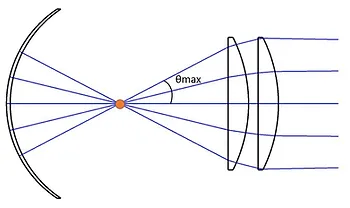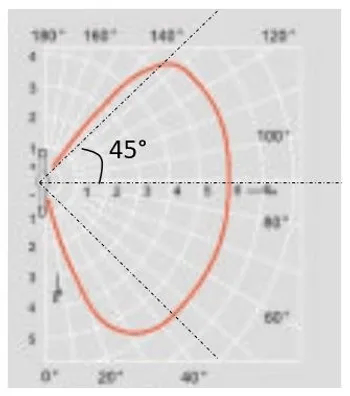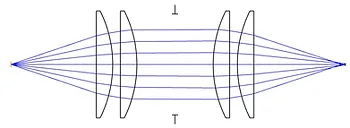In this article we provide hints for selecting the OPTEL Opole xenon light source that is most suitable for various common applications. Using geometrical optics model we estimate the efficiency of how each ILLU XBO transfers energy radiated from the source to the target. We consider following cases; collimated beam, M250 monochromator entrance slit, silica fiber with 1mm core diameter, light guide with a diameter of 5mm, plane with an area of 1 cm2.
Producers provide information about intensity of light generated by arc lamps in photometric quantities such as e.g. luminous flux [lm] and luminance [cd/cm2]. These are related to how a light source appears to the human eye. However, for most scientific applications radiometric quantities, which are purely physical, are more useful. Thus, in this article we use a simplified conversion, assuming that all power is radiated at single wavelength of 555 nm. Following that 1 lm is equivalent to 0,00147 W of radiated power [1].
The stndard OPTEL Opole condenser is a system of two plano-concave lenses made of fused silica, see Fig 1a). It has the working f/# of 1 according to the standard definition for collimated output beam. That corresponds to object space NA of 0,44. It additionally has back concentric mirror with an NA of 0,64 ,which is larger than in forward direction. Thus, the light collection efficiency of the condenser system is limited by the front lens system.

In order to estimate collection efficiency of the condenser system, the object size needs to be considered. According to the étendue constrain, which is derived from the energy conservation principle the product of the object size and the NA is constant. In case of the ILLU XBO light sources the light emitting area is the arc, which has different size depending on XBO lamp type. In our geometrical model the arc is a collection of point-like light sources radiating uniformly in all directions with an in-plane angle of 45 degrees [2].

In order to couple light into the entrance slit of the M250 monochromator a converging beam with a matching image space NA is required. That is obtained by moving the condenser lens system away from the light source, which to some degree decreases the collecting NA. For OPTEL monochromator M250 with the f-number of 5 the acceptance NA is 0,1. The width of the entrance slit can be regulated in the range from 0-3 mm, therefore light coupling efficiency is calculated for 1 mm and 0,2 mm opening.

In the table below results of the light collection efficiency of the standard double-lens condenser are presented. Results are evaluated with ZEMAX OpticStudio using Geometrical Image Analysis including the Fresnel losses.
| XBO75 | ||||
| XBO150CR | ||||
| XBO150 | ||||
| XBO450 | ||||
| XBO500H | ||||
| HBO200DC |
In case of coupling light into a fiber or a light guide, the adapter lens system is required. Single lens adapter system ADT_QRTZsingle is suitable for silica fiber with the core of 1mm and NA of 0,22. Double lens adapter system ADT_QRTZdouble is suitable for large diameter 7mm light guides such as a liquid light guide or a glass fiber bundle with NA>0,4.


into 1mm core, NA=0,22 fiber [%] |
into 5mm dia, NA=0,42 liquid light guide [%] |
||
|---|---|---|---|
| XBO75 | |||
| XBO150CR | |||
| XBO150 | |||
| XBO450 | |||
| XBO500H | |||
| HBO200DC |
It is important to note that our condensers are not corrected for chromatic aberrations. The general rule is that the shorter the wavelength, the shorter the focal length. Thus, the coupling efficiency for the UV light can be improved by moving the fiber closer towards the adaptor lens.
The above investigation shows that the higher the source power the more light can be coupled into the monochromator entarcance slit or large diameter light guide. However, in case of 1mm core silica fiber, increasing the source power has only small impact on the coupled power of light.
[1] J.R. Meyer-Arendt, Radiometry and Photometry: Units and Conversion Factors, Applied Optics Vol. 7, Issue 10, pp. 2081-2084 (1968)
[2] OSRAM XBO product datasheet